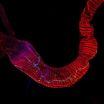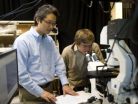(Press-News.org) Clues about how the human gut helps regulate our appetite have come from a most unusual source – fruit fly faeces. Scientists at the University of Cambridge are using the fruit fly to help understand aspects of human metabolism, including why pregnant women suffer from bloating and constipation, and even the link between a low calorie diet and longevity.
Although scientists have known for some time that there are as many as 500 million nerve cells in our gut, the sheer complexity that this presents means that little is known about the different types of nerve cell and their functions.
Now, researchers led by Dr Irene Miguel-Aliaga, with funding from the Wellcome Trust and the Biotechnology and Biological Sciences Research Council, have used the fruit fly, Drosophila melanogaster, to investigate the function of these intestinal neurons. The fly has simpler versions of our nervous and digestive systems, which lend it to genetic manipulation. Their findings are published today in the journal Cell Metabolism.
"We reasoned that what comes out of the gut may be able to tell us about what is going on inside," explains Dr Miguel-Aliaga. "So, we devised a method to extract information about several metabolic features from the flies' faecal deposits – which are actually rather pretty and don't smell bad. Then we turned specific neurons on and off and examined what came out."
Dr Miguel-Aliaga and colleagues found that these intestinal neurons have very important and specialised functions, such as regulating appetite or adjusting intestinal water balance during reproduction.
Female flies in their reproductive stage get constipated – their gut emptying rate is reduced even though they are eating more food; at the same time, they retain more water and the contents of their intestines become more concentrated. The researchers showed that these intestinal changes are triggered by the sex peptide, a hormone that males inject into the female during copulation, which activates of a small group of gut neurons. This shares the same function as the sex hormones found in humans, such as progesterone, oxytocin and oestrogen.
"Humans and fruit flies reproduce in very different ways, yet the associated symptoms of constipation and bloating and their cause – a reproductive hormone – are the same," explains Dr Miguel-Aliaga. "This suggests that this mechanism has been conserved through evolution. These intestinal changes may provide a benefit at a time of high nutritional demand by maximizing nutrient absorption."
The research also provides tantalising clues about the link between calorie intake and longevity. Intestinal changes which help maximize nutrient absorption would likely be active all the time, as they would provide a selective advantage when food is scarce. However, in flies – and possibly in humans – this may come at a cost: a shorter lifespan.
It has been known for some time that when female flies mate and receive the sex peptide, this shortens their lifespan; however, this is not caused entirely by their increased food intake or because they are laying many eggs, the two most obvious effects of this sex peptide. The explanation, argue the researchers, may lie in the intestinal changes triggered by the sex peptide that lead to constipation and water retention.
"A mechanism that maximises nutrient absorption by slowing the passage of food through the intestine is fine when food is scarce or during reproduction," says Dr Miguel-Aliaga, "but when we are eating a normal diet, constipation may lead to the build up of waste products produced during internal metabolism. Similarly, it could lead to changes in the composition of the gut bacteria, which are essential to regulating metabolism.
"Our research suggests that in addition to paying attention to what we eat, which has been the focus of longevity research, we may also have to consider what our body does with the food and what goes on in our guts."
INFORMATION:
Pregnant, constipated and bloated? Fly poo may tell you why
2011-01-06
ELSE PRESS RELEASES FROM THIS DATE:
MIT researchers study the danger of toxoplasma parasites
2011-01-06
CAMBRIDGE, Mass. -- About one-third of the human population is infected with a parasite called Toxoplasma gondii, but most of them don't know it. Though Toxoplasma causes no symptoms in most people, it can be harmful to individuals with suppressed immune systems, and to fetuses whose mothers become infected during pregnancy. Toxoplasma spores are found in dirt and easily infect farm animals such as cows, sheep, pigs and chickens. Humans can be infected by eating undercooked meat or unwashed vegetables.
Jeroen Saeij, an assistant professor of biology at MIT is investigating ...
Current smokers with early rheumatoid arthritis less responsive to TNF inhibitors, methotrexate
2011-01-06
Patients with early rheumatoid arthritis (RA) who are current smokers were less likely to achieve good response to methotrexate (MTX) and tumor necrosis factor (TNF) inhibitors than those who never smoked. The study by researchers from Sweden also found that RA patients who smoked in the past did not experience a lower response to these therapies. Results of the 10-year study appear in the January 2011 issue of Arthritis & Rheumatism, a journal published by Wiley-Blackwell on behalf of the American College of Rheumatology (ACR).
According to the World Health Organization ...
Accurate interpretation of antinuclear antibodies test key to confirming autoimmune disease
2011-01-06
The presence of antinuclear antibodies (ANA) indicates the possibility of autoimmunity and the indirect immunofluorescence (IIF) assay on HEp-2 cells is the standard blood test (ANA-HEp-2) used to detect ANA. However, studies have shown that a "false-positive" ANA test occurs in up to 13% of healthy individuals. In such cases the test detects the presence of autoantibodies that apparently are not associated with autoimmunity. Researchers from Brazil have now uncovered distinguishing characteristics of the ANA test in healthy individuals and patients with autoimmune disease, ...
Smithsonian instrument 'fills the gap,' views sun's innermost corona
2011-01-06
During a total eclipse of the Sun, skywatchers are awed by the shimmering corona -- a faint glow that surrounds the Sun like gossamer flower petals. This outer layer of the Sun's atmosphere is, paradoxically, hotter than the Sun's surface, but so tenuous that its light is overwhelmed by the much brighter solar disk. The corona becomes visible only when the Sun is blocked, which happens for just a few minutes during an eclipse.
Now, an instrument on board NASA's Solar Dynamics Observatory (SDO), developed by Smithsonian scientists, is giving unprecedented views of the ...
Clinical practitioners not adhering to evidence-based guidelines for osteoarthritis
2011-01-06
New research found clinicians who care for patients with osteoarthritis (OA) are likely not following standard care guidelines that are based on current medical evidence. Researchers noted physicians were prescribing medications for pain and inflammation, or opting for surgical interventions rather than recommending weight loss plans or exercise programs to OA patients. Details of the this study are available in the January 2011 issue of Arthritis Care & Research, a journal published by Wiley-Blackwell on behalf of the American College of Rheumatology.
A 2002 report ...
New solar cell self-repairs like natural plant systems
2011-01-06
WEST LAFAYETTE, Ind. - Researchers are creating a new type of solar cell designed to self-repair like natural photosynthetic systems in plants by using carbon nanotubes and DNA, an approach aimed at increasing service life and reducing cost.
"We've created artificial photosystems using optical nanomaterials to harvest solar energy that is converted to electrical power," said Jong Hyun Choi, an assistant professor of mechanical engineering at Purdue University.
The design exploits the unusual electrical properties of structures called single-wall carbon nanotubes, using ...
Wake up and smell the willow
2011-01-06
More plant matter could be burned in coal-fired power stations if this 'green' fuel was delivered pre-roasted like coffee beans, according to researchers from the University of Leeds, UK.
Many UK power stations are now burning plant matter, or biomass, as well as coal in a bid to cut their carbon footprint. Unlike fossil fuels, plants like willow, Miscanthus and poplar are a virtually carbon-neutral source of energy: the carbon dioxide emitted when they burn is absorbed during photosynthesis by the next batch of 'energy crops' planted in their place.
But the environmental ...
US does not have infrastructure to consume more ethanol
2011-01-06
WEST LAFAYETTE, Ind. - The United States doesn't have the infrastructure to meet the federal mandate for renewable fuel use with ethanol but could meet the standard with significant increases in cellulosic and next-generation biofuels, according to a Purdue University study.
Wally Tyner, the James and Lois Ackerman Professor of Agricultural Economics, and co-authors Frank Dooley, a Purdue professor of agricultural economics, and Daniela Viteri, a former Purdue graduate student, used U.S. Department of Energy and Environmental Protection Agency data to determine that the ...
Environmental Science & Technology special issue on environmental policy now online
2011-01-06
WASHINGTON, Jan. 4, 2011 — A special edition of the American Chemical Society journal, Environmental Science & Technology (ES&T), one of the world's premier environmental journals, is available now for a limited time online without charge. The special edition will be accessible free during 2011, when the world celebrates the International Year of Chemistry.
Entitled "Environmental Policy: Past, Present, and Future," the special issue of ES&T recognizes closure of a "green" decade in which people became more aware of environmental issues, and society marked the 40th anniversaries ...
Vaccine blocks cocaine high in mice
2011-01-06
NEW YORK (Jan. 4, 2011) — Researchers have produced a lasting anti-cocaine immunity in mice by giving them a safe vaccine that combines bits of the common cold virus with a particle that mimics cocaine.
In their study, published Jan. 4 in the online edition of Molecular Therapy and funded by the National Institute on Drug Abuse, the researchers say this novel strategy might be the first to offer cocaine addicts a fairly simple way to break and reverse their habit, and it might also be useful in treating other addictions, such as to nicotine, heroin and other opiates.
...



